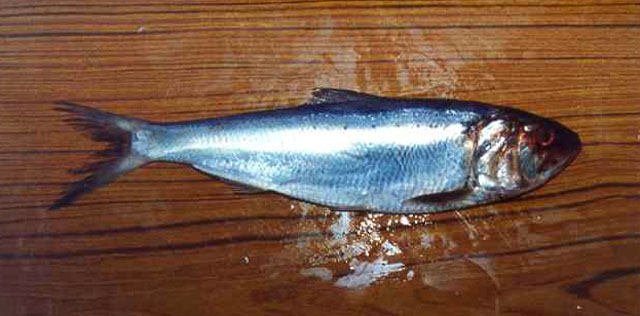| Clupeidae (Herrings, shads, sardines, menhadens), subfamily: Alosinae |
| 69 cm TL (male/unsexed); 83 cm TL (female); max.weight: 4,000.0 g; max. reported age: 10 years |
|
pelagic-neritic; depth range 10 - 300 m, anadromous |
| Eastern Atlantic: from southern Norway and along the coasts of Europe to northern Mauritania (Ref. 188, 6683), including the Western Baltic Sea up to the Kaliningrad Oblast (Ref. 12801, 26334, 59043), the western part of Mediterranean Sea (Ref. 188, 6683, 59043) and the coast of northern Africa (Ref. 3509). Outside France this species is rare (Ref. 89646).
Listed in Appendix III of the Bern Convention (2002).
Listed in Annex II and V of the EC Habitats Directive (2007). |
|
Dorsal spines (total): 0-0; Dorsal soft rays (total): 18-21; Anal spines: 0-0; Anal soft rays: 20-27; Vertebrae: 57-58. Diagnosis: Body somewhat compressed, fairly deep with depth at pectoral fin more than head length, scutes apparent along belly (Ref. 188, 51442). Upper jaw notched, lower jaw fitting into it; no teeth on vomer; gillrakers long, thin and numerous, a total of 85 to 130, longer than gill filaments (Ref. 188). A dark spot posterior to gill opening, but sometimes absent, occasionally 1 or 2 more spots (Ref. 188). Alosa alosa resembles Alosa fallax, which has fewer and shorter gillrakers and 7 or 8 black spots along flank (Ref. 188).
Description: Gillrakers long, thin and numerous, a total of 85 to 130, longer than gill filaments; 55-85 gillrakers on lower part of anterior arch (Ref. 188, 11601). Number of dorsal fin rays 18 to 21; number of anal fin rays 22 to 27 (Ref. 11601). Large, thin scales; 70-86 scales in a longitudinal and 22-26 in a transverse series (Ref. 11601, 51442, 52923). Presence of abdominal scutes (Ref. 51442).
Colouration: Deep blue dorsally, becoming greenish brown or golden on the sides and silvery ventrally; a single dusky spot before the gill opening (sometimes absent) and occasionally 1-6 more dusky spots behind it (Ref. 188, 52923, 88187). |
| Amphihaline species, schooling and strongly migratory, penetrating far up rivers but not into small tributaries (Refs. 188, 59043). Adults are usually found in open waters along the coast (Ref. 51442). In freshwater, inhabits major rivers but may also enter tributaries, if water temperature is equal to or is warmer than the main river (Ref. 188, 10536). Known lake populations from Morocco and Portugal need access to rivers to spawn (Refs. 10536, 89647, 89648). Larvae and small juveniles inhabit deep slow-flowing areas of rivers (Ref. 89649), some swimming upstream in late summer and autumn (Ref. 10536). Juveniles (up to 1+ years) are usually found near estuaries or river mouths (Refs. 10536, 59043), possibly making vertical diurnal movements synchronized with the tides; they remain in estuaries for over one year (Ref. 89630). Feeds on a wide range of planktonic crustaceans; larger adults feed on small schooling fishes (Ref. 188, 51442, 59043). Juveniles in freshwater prey on insect larvae. Females in European rivers commonly reach 70 cm total length (Ref. 10536). Females grow faster and are always larger than males of the same age (Ref. 10536). Less common than Alosa fallax but both have suffered from pollution and weirs or other obstructions (Ref. 188). It has been suggested that members of the genus Alosa are hearing specialists with the American shad (Alosa sapidissima) having been found to detect and respond to sounds up to at least 180 kHz (Ref. 89631). This may aid in predator avoidance (e.g. cetaceans) (Ref. 89632). Hybridization with the twaite shad (Alosa fallax) has been reported from the Rhine (Ref. 89633) as well as from rivers in France and Algeria (Ref. 10536). Shad hybrids may reproduce (Ref. 27567). Marketed fresh and frozen; eaten sautéed, broiled, fried and baked (Ref. 9988). |
|
(Ref. 96402)
|
| harmless |
|
Source and more info: www.fishbase.org. For personal, classroom, and other internal use only. Not for publication.
Page created by Jen, 05.08.02,
php script by kbanasihan 06/09/2010 ,
last modified by
dsantos, 20/08/10

